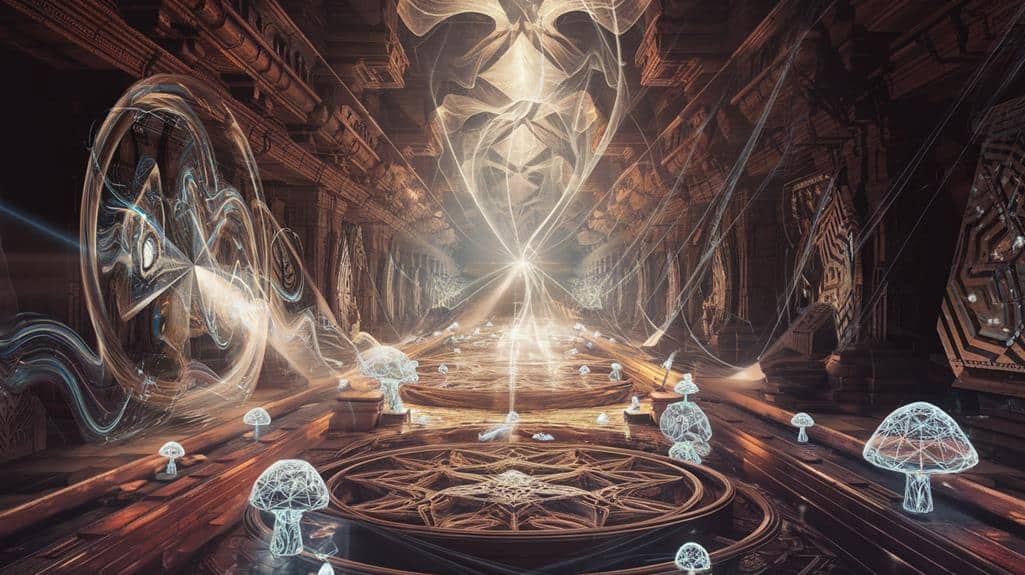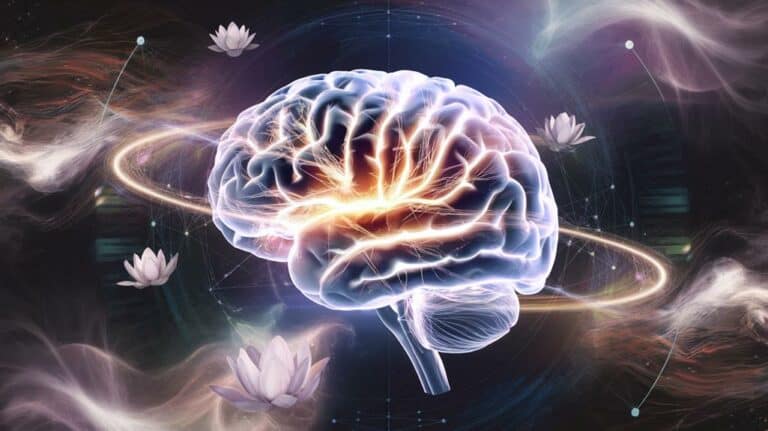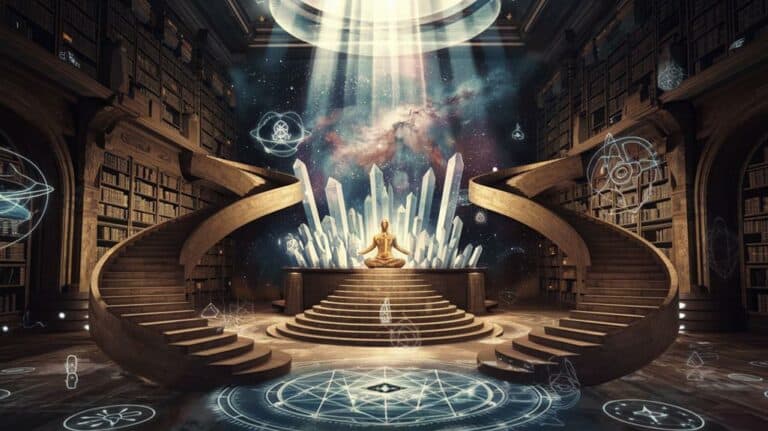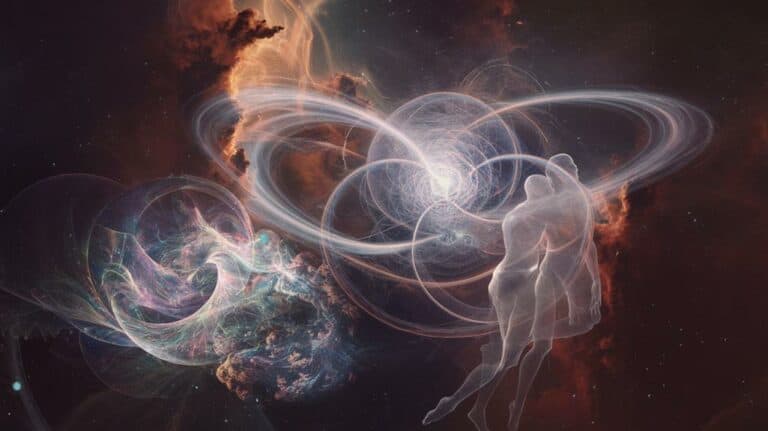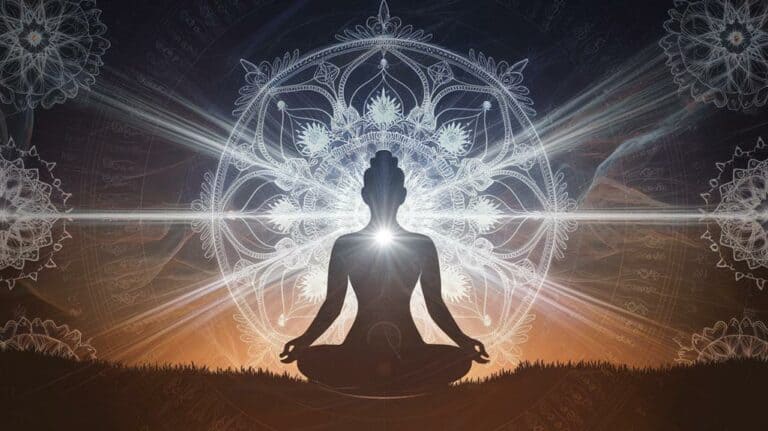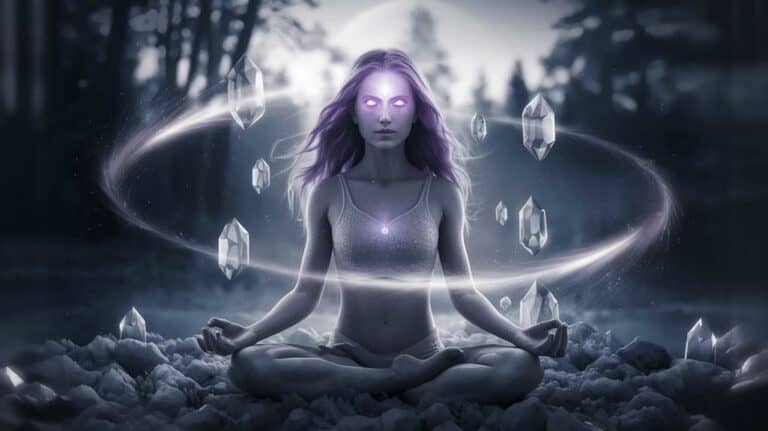The Relationship Between Mysticism and Psychedelic Substances
You’ve likely heard whispers of ancient ceremonies where sacred plants opened doorways to divine domains, but you might not realize how deeply intertwined mysticism and psychedelics remain in human consciousness. From the temple mysteries of Greece to the peyote rituals of Native Americans, these substances have served as bridges between ordinary reality and transcendent states of being. As modern science begins to validate what shamans have known for millennia, you’ll discover how these powerful compounds continue to reshape our understanding of consciousness, spirituality, and the human potential for transformation. Let’s explore this fascinating intersection of the sacred and the scientific.
Historical Context and Sacred Origins
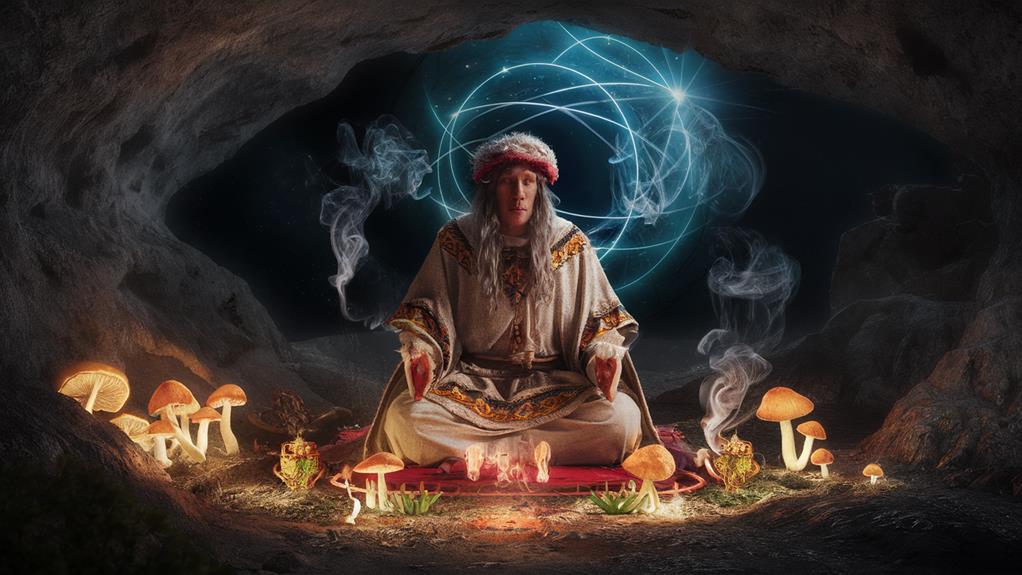
Many ancient civilizations integrated psychedelic substances into their spiritual and religious practices, dating back thousands of years. You’ll find evidence of these sacred relationships across cultures, from the soma of Vedic traditions to the mushroom stones of Mesoamerica. These weren’t mere intoxicants but rather served as bridges between the material and divine domains, offering you glimpses into what your ancestors considered sacred territory.
As you explore deeper into history, you’ll discover that indigenous shamans and spiritual leaders carefully guarded these substances, treating them with profound respect and embedding their use within structured ceremonial contexts.
They understood what you’re now rediscovering: these compounds weren’t meant for casual consumption but rather served as tools for spiritual exploration, healing, and communion with the divine.
In the Amazon, you’ll find the continued use of ayahuasca in traditional ceremonies, while in Central America, peyote remains a sacred medicine among Native American communities.
These practices have survived centuries of suppression, speaking to their deeply rooted significance in human spiritual experience and their enduring role in our quest for transcendent understanding.
Ancient Shamanic Wisdom
Traditional shamanic practices offer profound insights into the responsible use of psychedelic substances. When you explore these ancient traditions, you’ll discover that shamans have long understood these compounds not as recreational tools, but as sacred medicines that bridge the physical and spiritual domains. Their wisdom teaches you to approach these experiences with reverence, preparation, and clear intention.
You’ll find that shamanic traditions emphasize the importance of set, setting, and spiritual guidance. Through their centuries-old protocols, you’re taught to create sacred spaces, engage in purification rituals, and align your consciousness with the natural world before starting on these profound journeys.
The shamanic perspective reminds you that you’re not just ingesting a substance – you’re entering into a relationship with plant teachers who’ve guided humanity’s spiritual evolution for millennia.
Ancient wisdom keepers have shown that these experiences aren’t meant to be pursued in isolation. You’re encouraged to integrate your insights within a community context, where experienced elders can help you interpret and apply the knowledge you’ve gained, ensuring that your encounters with the sacred serve both personal and collective evolution.
Religious Sacraments Through Time
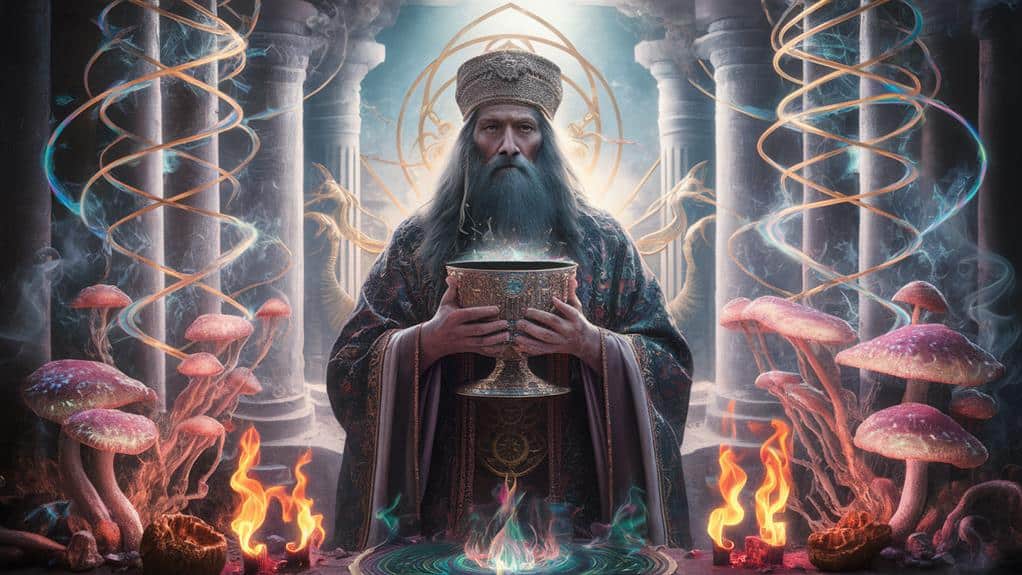
Throughout history, sacred substances have played pivotal roles in religious ceremonies across diverse faiths and cultures. You’ll find evidence of these practices woven into humanity’s spiritual fabric, from the soma of ancient Vedic traditions to the ceremonial use of wine in Christianity.
As you explore these traditions, you’ll discover how different cultures have sought to bridge the divine and earthly domains through carefully chosen sacramental elements.
When you examine the archaeological record, you’ll notice that many indigenous peoples incorporated specific plants and fungi into their religious rituals, believing they’d open doorways to spiritual dimensions.
You might recognize how the Aztecs revered certain sacred plants as flesh of their deities, while ancient Greek mystery schools employed special preparations during their initiation rites.
Even today, various religious communities continue to use sacramental substances as tools for transcendence and communion with the divine.
You’re witnessing a pattern that spans continents and millennia, where humans have consistently turned to these sacred substances to facilitate their connection with the ineffable, suggesting an enduring relationship between material sacraments and spiritual exploration.
Modern Scientific Research Findings
Scientific breakthroughs in psychedelic research have revealed remarkable patterns in how these substances affect human consciousness and brain function.
You’ll find that studies using modern brain imaging techniques show these compounds create unique neural patterns, often linking previously disconnected brain regions and temporarily disrupting the default mode network – that mental framework you rely on for your everyday sense of self.
Research at institutions like Johns Hopkins and Imperial College London has documented how psychedelics can induce mystical experiences that you might find indistinguishable from those reported by lifelong contemplatives.
You’re looking at data that shows profound shifts in perspective, with up to 80% of participants rating their psychedelic sessions among life’s most meaningful experiences. The evidence suggests these substances can reduce activity in your brain’s fear centers while enhancing emotional processing and introspection.
What’s particularly fascinating is how you’ll see these findings bridging ancient wisdom with modern neuroscience.
The research validates what indigenous cultures have long known: these compounds can facilitate profound shifts in consciousness that you might otherwise spend decades pursuing through traditional contemplative practices.
Mystical States and Brain Chemistry
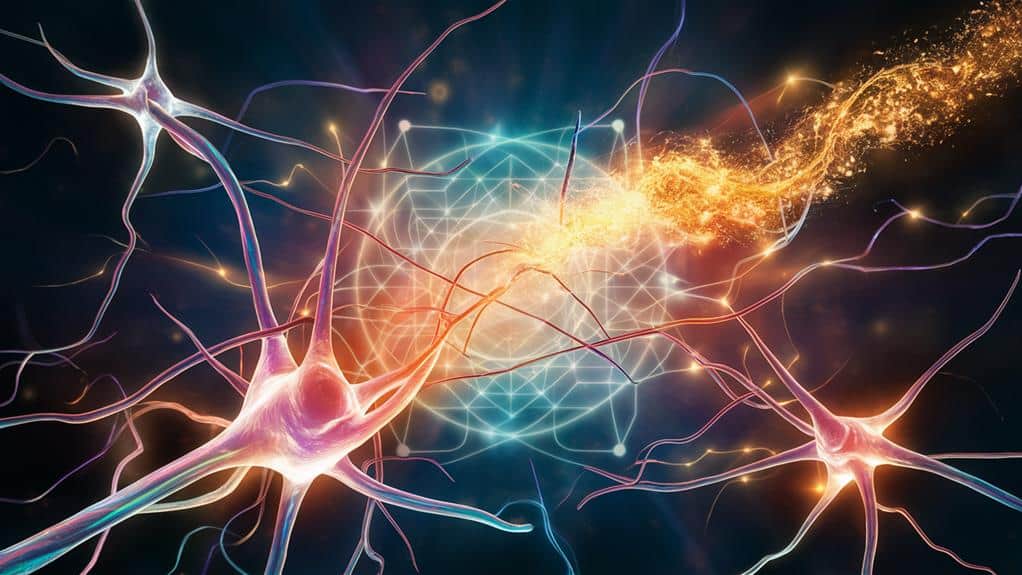
When you experience mystical states, whether through meditation or psychedelic substances, specific neurochemical changes occur in your brain. Your default mode network, responsible for your sense of self, shows reduced activity while other neural pathways form novel connections.
You’ll find your serotonin and dopamine systems actively engaging in ways that dissolve ordinary boundaries of consciousness, creating what many describe as a sense of profound unity with existence.
These neurological shifts aren’t merely random chemical fluctuations – they represent your brain entering distinct states of heightened interconnectivity. You’re experiencing what neuroscientists call “ego dissolution,” where the boundaries between self and universe become permeable.
Your brain’s usual patterns of self-referential thinking give way to broader, more inclusive states of awareness. The mystical experiences you encounter correlate with increased activity in your parietal lobe, which processes sensory information and spatial awareness, while your prefrontal cortex shows altered patterns that correspond with transcendent states.
These changes mirror what researchers observe in long-term meditators during their deepest states of contemplation, suggesting common neural pathways to mystical consciousness, regardless of the catalyst.
Cultural Impact and Social Evolution
The cultural impact of mystical experiences and psychedelic substances has profoundly shaped human societies across millennia. You’ll find their influence woven into the fabric of religious ceremonies, artistic expressions, and philosophical inquiries that have guided humanity’s search for meaning and transcendence.
When you examine indigenous cultures, you’ll discover that their relationships with sacred plants and mystical practices have fostered communal bonds and spiritual understanding that continue to resonate in contemporary society.
These traditional wisdom systems have evolved alongside modern scientific inquiry, creating bridges between ancient knowledge and current understanding of consciousness and human potential.
You’re living in an era where the integration of mystical experiences and psychedelic substances into mainstream discourse has sparked a renaissance in mental health treatment and spiritual exploration.
This shift has challenged conventional paradigms, encouraging you to reconsider the boundaries between science and spirituality.
As societies grapple with existential challenges, these ancient tools for accessing altered states of consciousness offer insights into human interconnectedness and ecological awareness, potentially catalyzing social evolution toward more conscious and compassionate ways of being.
Therapeutic Applications and Healing
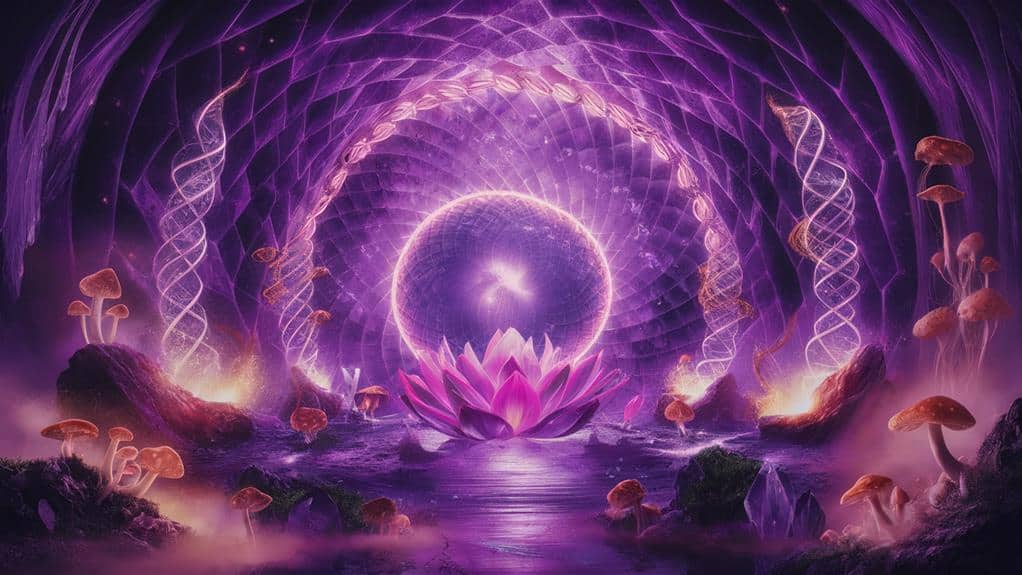
Modern medicine’s integration of mystical experiences and psychedelic substances has revolutionized therapeutic approaches to mental health treatment. You’ll find that leading institutions are now embracing these powerful tools for addressing depression, PTSD, and existential anxiety, particularly when traditional methods haven’t provided adequate relief.
Within supervised therapeutic settings, you’re able to explore profound states of consciousness that can help you process deep-seated trauma and connect with parts of yourself that may have remained hidden. The mystical experiences facilitated by these substances often allow you to transcend ordinary perception, offering insights that can fundamentally reshape your relationship with pain, fear, and personal limitations.
You’ll discover that the healing potential extends beyond immediate psychological relief, as these experiences often catalyze lasting spiritual transformations. When you engage with these therapies, you’re not just treating symptoms but potentially restructuring your entire framework of understanding yourself and your place in the universe.
The integration of ancient wisdom traditions with modern therapeutic protocols has created a bridge between scientific methodology and transcendent healing, offering you a path to both psychological wellness and spiritual wholeness.
Comparative Religious Perspectives
Building on these therapeutic insights, various religious traditions throughout history have acknowledged altered states of consciousness as gateways to spiritual revelation.
You’ll find that indigenous shamanic practices, Hindu mysticism, and certain Buddhist traditions have long recognized the potential of consciousness-altering methods to facilitate direct encounters with the divine. While some traditions employ meditation, fasting, or breathwork, others have historically incorporated sacred plant medicines into their ceremonial practices.
When you examine these diverse approaches, you’ll notice striking parallels in how different cultures describe their mystical experiences, whether induced naturally or through entheogenic substances.
From the soma of ancient Vedic texts to the teonanácatl of Mesoamerican cultures, you’re witnessing a universal human yearning to transcend ordinary consciousness and connect with something greater.
Modern researchers have documented how the mystical experiences reported by contemporary psychedelic users often mirror those described in religious texts: ego dissolution, unity with the divine, and profound insights into the nature of reality.
These cross-cultural similarities suggest you’re exploring a fundamental aspect of human consciousness that transcends cultural and historical boundaries, pointing toward shared spiritual truths that lie beyond ordinary perception.
Ethics and Responsible Practice
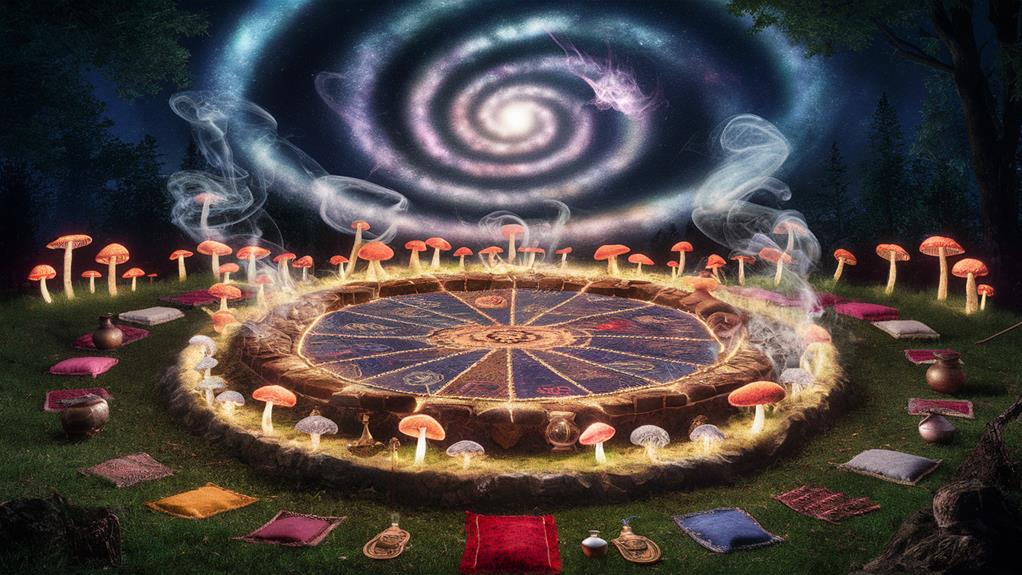
Safety and ethical considerations must ground any exploration of psychedelic substances in spiritual contexts. You’ll need to approach these powerful tools with reverence, understanding that they’re not mere recreational substances but potential gateways to profound spiritual experiences that demand careful preparation and integration.
When you’re engaging with psychedelics for mystical purposes, you’ll want to establish clear boundaries and protocols. This includes choosing appropriate settings, working with qualified guides when possible, and ensuring you’re emotionally and mentally prepared for potentially transformative experiences.
You’ll find it’s vital to respect traditional wisdom while adapting practices to contemporary contexts. You’re responsible for understanding the legal implications in your jurisdiction, as many psychedelic substances remain controlled substances.
Beyond legality, you’ll need to reflect on the ethical dimensions of sourcing materials and the impact of your practices on Indigenous communities who’ve historically stewarded these sacred medicines.
Integration work becomes significant – you’ll want to process and ground your experiences through meditation, journaling, or working with integration specialists to honor the insights you’ve received and apply them meaningfully to your life.
Future of Consciousness Exploration
The emerging landscape of consciousness exploration stands at a pivotal intersection of ancient wisdom and cutting-edge neuroscience. As you navigate this terrain, you’ll witness the convergence of traditional mystical practices with modern therapeutic applications, creating unprecedented opportunities to understand the depths of human awareness.
You’re living in an era where established institutions are beginning to recognize the validity of altered states, while research centers worldwide are mapping the neural correlates of transcendent experiences. Through this synthesis, you’ll find that your journey into expanded consciousness doesn’t require choosing between scientific rigor and spiritual insight – they’re becoming complementary paths toward the same summit of understanding.
As you look toward the horizon, you’ll see that the future of consciousness exploration isn’t just about individual transformation – it’s about collective evolution. The tools and technologies emerging today, from brain-computer interfaces to refined psychedelic medicines, will offer you new windows into the nature of awareness itself.
This convergence of ancient wisdom traditions with contemporary scientific methods isn’t just reshaping how you understand consciousness – it’s redefining what it means to be human.



